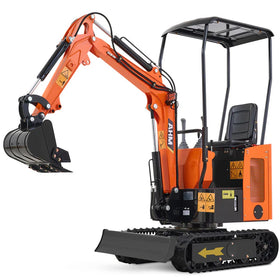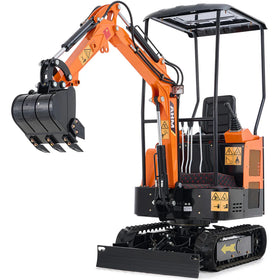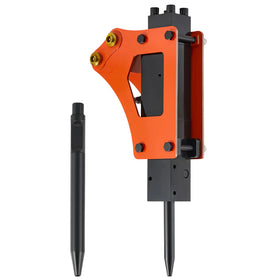Clearing a construction site poorly can lead to multiple problems, including project delays, safety hazards, and foundation problems that can cost you thousands to fix later. Understanding how to clear a construction site properly will prevent these issues and create a solid, safe base for beginning your construction.
Professionals typically charge $500 to $5,000 per acre for site clearing, depending on the density of the vegetation and the type of terrain, which is why getting it right the first time saves tons of money compared to fixing drainage problems, removing missed stumps that crack foundations, or dealing with soil instability later on.

How to Clear Land for Construction (Six Steps)
Clearing land for construction should be done in a structured way to prevent reworks and to ensure the site meets building requirements. Skipping these steps or doing them out of order will inevitably create problems that will delay your projects.
1. Start by Surveying and Marking Boundaries
Professional land surveying is essential to establish the exact property lines and construction zones before any clearing begins. This prevents legal disputes and ensures you only clear the land you're authorized to work on.
- Hire a licensed surveyor to establish property boundaries
- Mark the cleared area with stakes and bright flagging tape
- Document existing structures and utilities on site
2. Remove Vegetation
Start removing vegetation with the undergrowth and then progress to the larger trees and shrubs. Clearing the undergrowth first creates a safer workspace for tree removal equipment.
- Cut grass, weeds, and small brush first
- Remove shrubs and small vegetation
- Cut trees, leaving tall stumps for easier removal
- Trees within 30 feet of the construction site should be cleared
- Sort the vegetation for recycling or disposal
3. Uproot Stumps and Roots
Stump and root removal is important to prevent future cracking in buildings and concrete structures. Decaying woody material under foundations can lead to settlement and structural damage.
- Cut stumps as low to the ground as possible
- Use mini excavators to dig out stumps and root systems
- Grind stumps below ground level using a stump grinder attachment
- Remove any major roots extending from the stump area
- Fill the holes with compacted soil
4. Dispose of Debris
Follow environmental regulations and maximize recycling when you’re disposing of the debris.
- Transport vegetation to recycling facilities
- Haul debris to approved disposal sites
- Chip and mulch wood material on site for reuse
- Remove large stones and rocks
- Fill animal burrows with compacted clay
5. Do Some Rough Grading
Land grading is the process of shaping the land to create a level, stable surface for the building's foundation, including cutting (removing excess earth) and filling (adding soil) to achieve a suitable slope and elevation for construction.
- Remove surface soil with a high concentration of roots and organic material
- Level ground to improve drainage patterns
- Create an even working surface for the construction equipment
- Establish slopes directing water away from structures
- Compact soil to the specified density requirements
6. Proceed to Erosion Control
Install temporary erosion control measures to prevent soil loss during construction.
- Install silt fences along the site perimeter
- Create temporary drainage ditches to channel water
- Place erosion control barriers in critical areas
- Plant some temporary vegetation on exposed soil
- Implement stormwater management measures according to local regulations

Mini Excavators vs Mini Skid Steer Loaders for Construction Site Clearing
When to Use a Mini Excavator For Construction Site Clearing
Mini excavators are best for their ability to perform detailed excavation tasks with precision, with the 360-degree rotation ideal for digging in confined spaces. Here are the top benefits of mini excavators for construction site clearing:
- Precision trenching for utilities and foundations
- Deep digging for stump and root removal
- 360-degree cab rotation allows working without repositioning
- Rubber tracks handle soft, unstable terrain better
- Powerful digging force for breaking compacted soil
When a Skid Steer Is Better
Skid steer loaders handle material movement, debris clearing, and surface preparation more efficiently than excavators.
Advantages:
- Let's you load and transport cleared vegetation faster
- 100+ attachment options for different tasks
- Better for grading large open areas
- Faster travel speed between work areas
- Works better on hard, firm ground
Try AHM's Skid Steer for Construction Site Clearing
The AHM SS-38 mini skid steer at 1,733 pounds and 45.3 inches wide is built to handle construction site clearing efficiently while fitting through standard gates. With 827 pounds of lift capacity and compatibility with multiple attachments, this machine can tackle debris removal, material handling, and surface preparation without hassle.
- 827 lb lift capacity handles loaded buckets of debris
- 5.4 cu. ft. bucket moves substantial material per load
- 23 HP engine provides power for large-scale work
- 3.7 mph travel speed
- 30-degree climbing ability

Recommended Mini Excavators for Construction Site Clearing
1. AHM AX-12B - $5,699.99
The AX-12B comes in at 2,138 pounds and delivers the precision excavation capability you’ll need for site clearing. With 69 inches of digging depth and 2,585 lbf digging force, this compact excavator removes stumps and handles detailed excavation in 37-inch-wide spaces.
- 69-inch digging depth for stump removal
- 2,585 lbf digging force breaks through roots
- 120-inch digging radius provides good reach
- 37-inch width fits tight residential spaces
AHM NW-A1 - $7,399.99
The NW-A1 provides the AX-12B's excavation capability plus six essential attachments in one package. This complete setup handles every step of site clearing from vegetation removal through final grading without requiring you to purchase any additional attachments.
- Quick hitch for fast attachment changes during clearing
- Grading bucket for surface leveling after removing vegetation
- Grapple for moving brush, logs, and debris efficiently
- A rake for separating rocks and debris from soil
- Hydraulic hammer for breaking up concrete or hard surfaces
- Auger for post holes and foundation drilling
AHM AX-15 - $7,999.99
The AX-15 with Kubota D722 engine delivers superior reliability for commercial clearing operations. The engine runs three times longer than standard engines, making it ideal for contractors handling multiple clearing projects where downtime costs money.
- 2,698 lbf digging force handles tough stumps and compacted soil
- Kubota engine provides consistent power throughout long clearing days
- EPA Tier 4 compliance meets environmental requirements
- External hydraulic hoses simplify maintenance during clearing projects.
 The Bottom Line
The Bottom Line
The correct answer to ‘How to clear a construction site?’ includes removing vegetation systematically, stump extraction, disposing of debris, rough grading, and erosion control. Mini excavators handle precision digging and stump removal better, while skid steers excel at material handling and surface grading.
The AHM lineup covers both needs - skid steers for material movement, and excavators for digging and stump removal. Follow the proper clearing sequence and match equipment to tasks, and your site will be construction-ready before you know it.







